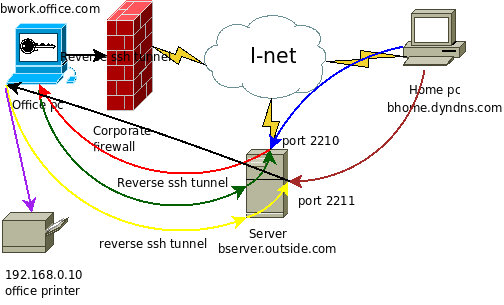
- #SCRIPT VPN SETUP SSH TUNNEL HOW TO#
- #SCRIPT VPN SETUP SSH TUNNEL SOFTWARE#
- #SCRIPT VPN SETUP SSH TUNNEL CODE#
- #SCRIPT VPN SETUP SSH TUNNEL PASSWORD#
#SCRIPT VPN SETUP SSH TUNNEL PASSWORD#
If you’ve done everything correctly, you will be asked for your password on the remote machine. Run the following in your terminal: ssh -p 2222 with the username on your office PC. Now, after you have created the tunneling rule and connected to the remote side, it’s time to test the SSH connection. I use the file transfer mode to save traffic and CPU time. The type of connection doesn’t matter, the tunnel will work in both normal and file transfer modes. This tunnel will be activated as soon as you connect to the corresponding AnyDesk ID. The exact port number doesn’t matter, we use 2222 as an example in this case.

In the example above, we are forwarding the TCP port 22 of the remote machine (the remote port used by SSH) to the local port 2222. To forward the SSH port we need to add a rule into the setup window: TCP tunneling setup For our purpose, we select the direct tunnels. In the dialog box, you’ll see the settings for direct and reverse tunnels. To do so, open the TCP tunneling settings from the context menu of the address tile: Context menu in Recent Sessions Using the TCP Tunneling Feature of AnyDesk you can set up a tunnel to the remote computer and use SSH almost as if the two computers were in the same network. With AnyDesk, however, one can connect to any computer regardless of any firewalls or NATs. Usually this is not the case when you are connecting to your office PC from home. This happens, for example, if the host is on the same local network or has an external IP address. SSH, like any other TCP connection, is only possible when the host you are connecting to is visible from your local computer. Setting Up a Direct Tunnel Connection With SSH This solution is much more CPU and traffic-efficient than the classical Remote Desktop Access.

#SCRIPT VPN SETUP SSH TUNNEL HOW TO#
In this article I will show you how to mount a remote folder locally using TCP Tunneling with AnyDesk for Linux but it’s also available for Windows and macOS devices. With AnyDesk you can set up a TCP tunnel connection which allows you to access files on a remote device locally without having to download them on your local machine.
#SCRIPT VPN SETUP SSH TUNNEL CODE#
Being able to access a source code locally can often make things faster and more comfortable.
#SCRIPT VPN SETUP SSH TUNNEL SOFTWARE#
Trying to connect from a different terminal caused the terminal to freeze.Mount Remote Folders Locally With an AnyDesk TCP Tunnelįor a software developer, Remote Work can be a challenge. This was my case, and lead me to the conclusion that the problem involved the browser. If that is the case, your SSH tunnel is working. Typing hello and pressing enter should print hello back.


I still don't know what could be the reason for that (didn't look much into it but if anybody knows please let know!), but I solved it switching to ubuntu's default browser. In my case (firefox+ubuntu16) the browser was connecting, but showing a blank page (with the tensorboard logo on the tab), and no log activity at all was shown. This is not a proper answer but a troubleshooter, hopefully helps other less seasoned networkers like me.


 0 kommentar(er)
0 kommentar(er)
